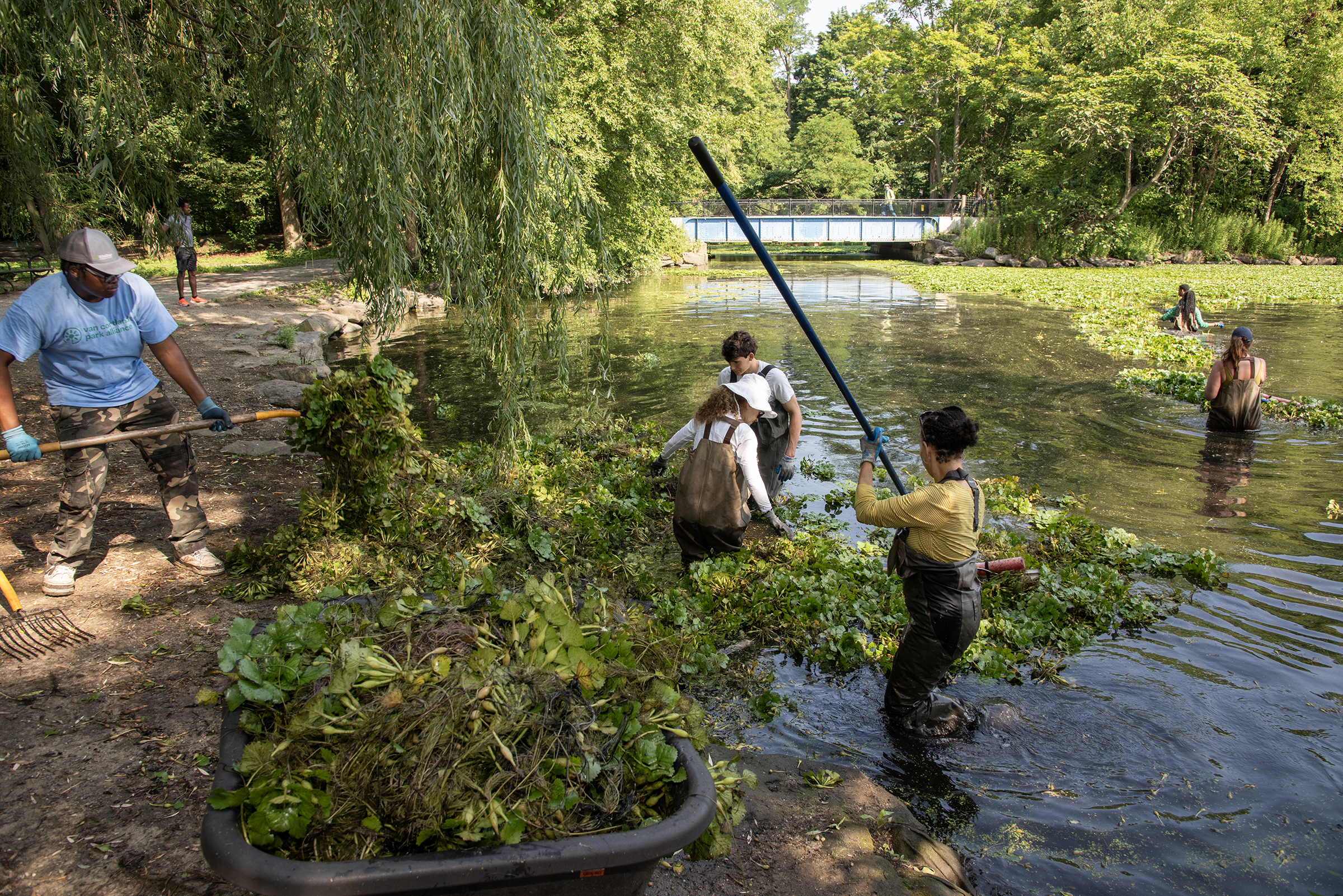
For most of the year, visitors to Van Cortlandt Park’s Hester & Piero’s Mill Pond are usually entertained by throngs of duck and geese flying and landing on the water. However, when the weather gets warm, an unwelcome, invasive guest makes an appearance, hindering the fowls’ routine of take-off and landing. That invader goes by the name “water chestnut.”
Water chestnut is not, in fact, a nut but an aquatic vegetable that, according to New York Invasive Species Information Clearinghouse (NYIS.INFO), is “inexorably spreading throughout New York State, clogging waterways, lakes and ponds and altering aquatic habitats.”
Not to be confused with the edible water chestnut that can be purchased in cans at the local supermarket, the species in Van Cortlandt Park’s pond has simulated a green carpet over the pond with just a few patches of water visible, and nary a duck or goose in sight.
To rid the pond of this unsavory, aquatic invader, on July 12, Van Cortlandt Park (VCP) Alliance gathered a team of workers, which included high school interns from the Urban Eco-Teens program and other volunteers.
Duly suited up in waterproof overalls known as waders, for the second time this summer, the group waded through the shallow parts of the pond, armed with rakes, and duly cleaned the waterway. Starting at 9 a.m. on what VCP Alliance calls “Water Chestnut Wednesdays,” the team will continue to gather each Wednesday through Aug. 9 in the clean-up effort.
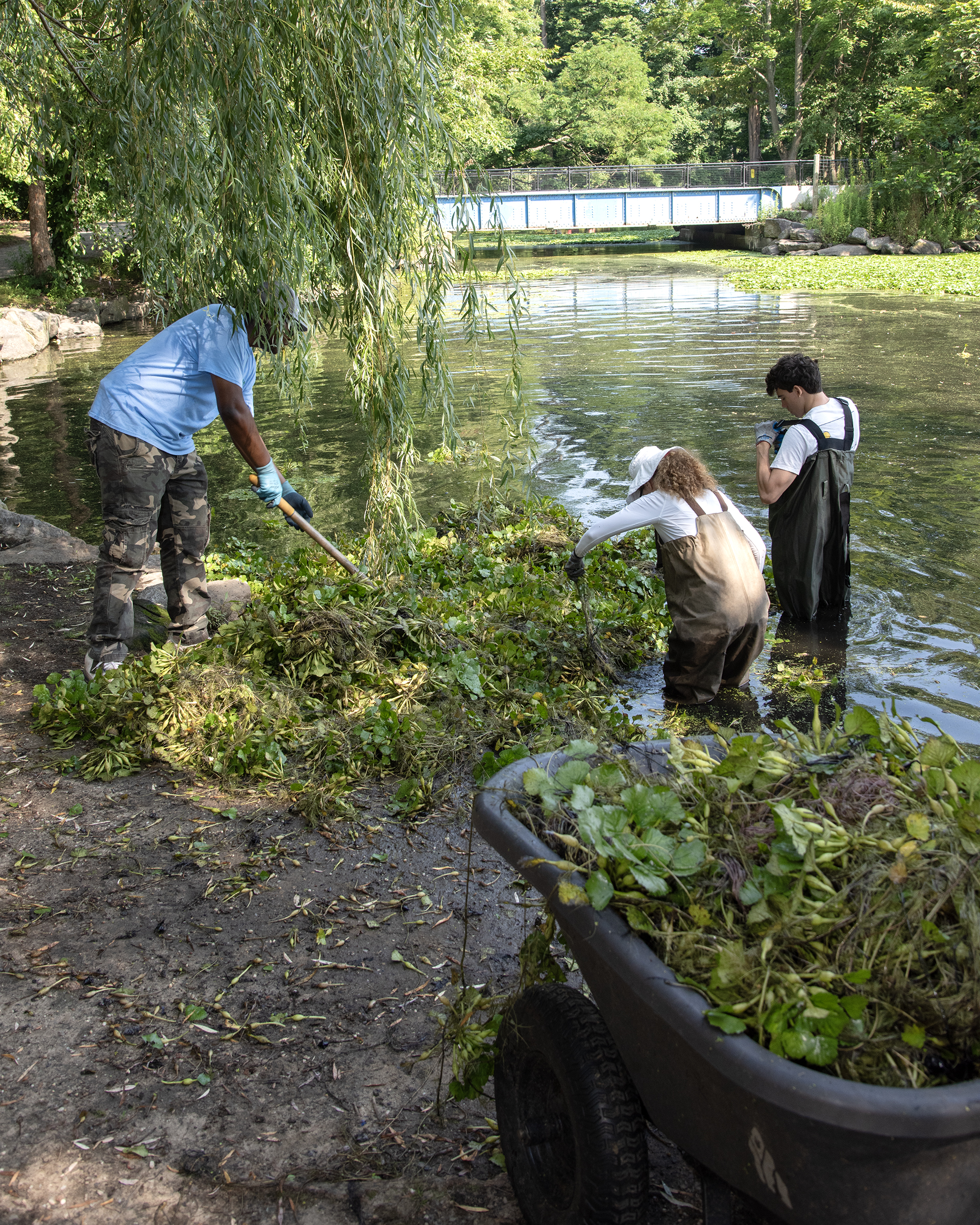
Photo by José A. Giralt
VCP Alliance officials said the overgrowth of water chestnuts is not new to the park’s pond and has been cleared during the summer months for several years now. “For a while it looked like we were making good progress,” said Christina Taylor, deputy director of the Alliance. “This year, I’m not quite sure if it was because it was such a mild winter, but the water chestnut came up much sooner and much faster than it has in the past, and it’s just covering the entire Mill Pond.”
Interestingly, the invasion does not originate in any flora located in the Bronx park but in Yonkers, just a few miles north. “The seeds were coming down from Tibbetts Brook Park,” Taylor said. “We talked to them [Yonkers’ park administration] and said, ‘Hey, you guys need to get your pond under control because until you do, we can’t get ours under control’.”
She credits Yonkers for doing a “pretty good job” in managing their water chestnut problem. Taylor does, however, point to a potential long-term problem with the clean-up efforts. “The seeds can actually stay dormant in the soil at the bottom of the pond for 10 years,” she said. “So, this is going to be a continual problem.”
Taylor acknowledges that future clean-up efforts may be beyond the capacity of the manual labor the interns and volunteers provide. She said one option is to bring in a harvester, a machine that floats on the water and is designed to remove aquatic weed.
This would eliminate the need for most of the manual labor needed to clean up Hester & Piero’s Mill Pond, with a few exceptions. Noel Hefele is the volunteer coordinator with VCP Alliance and points out what those exceptions would be.
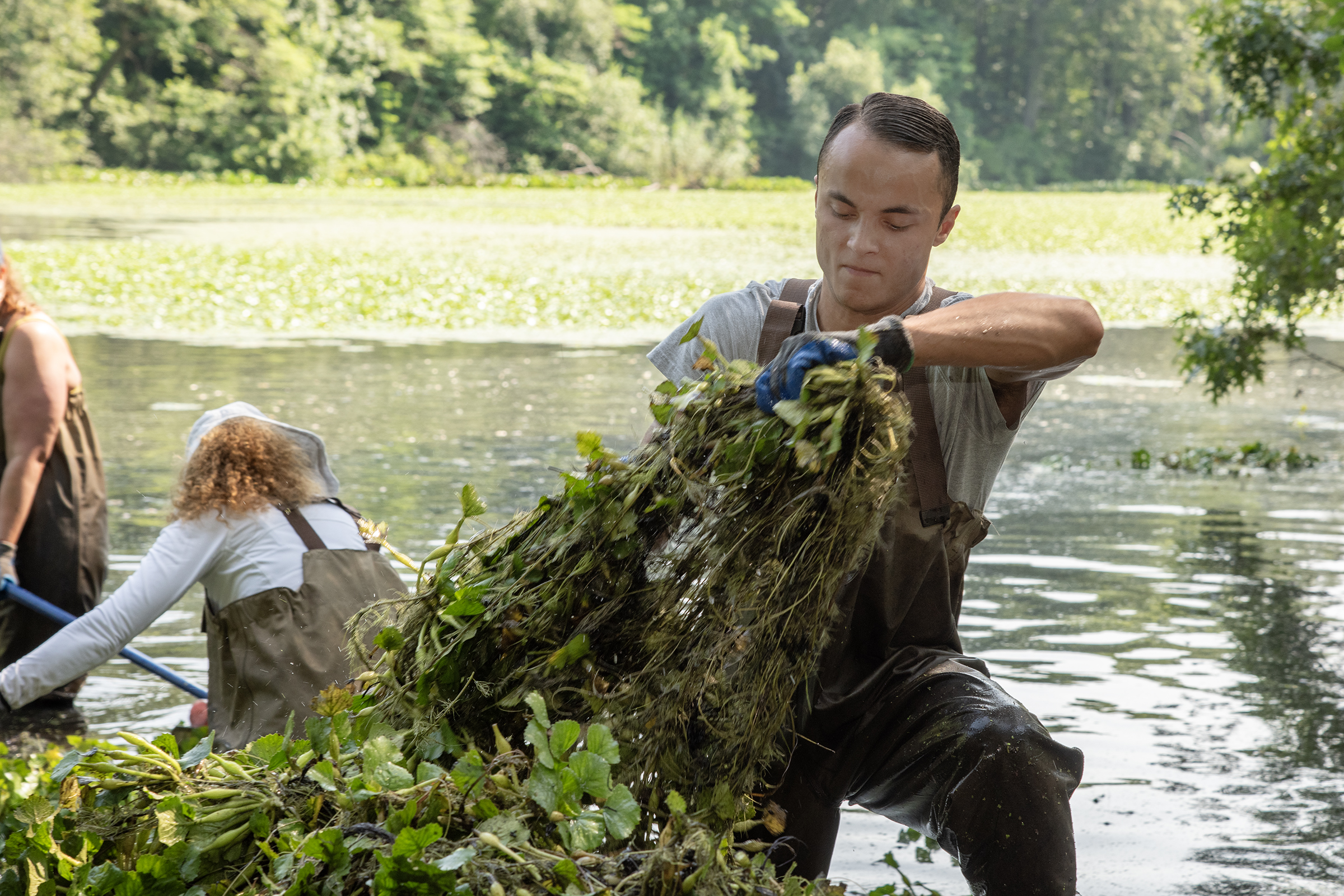
Photo by José A. Giralt
“We do need the help of the harvester machine,” he said. “Hand pulling alone is not going to win the battle, but hand pulling is essential for areas where the machine will not be able to access. We can do the finer detail work such as pulling around some of the species we want to keep in the lake, like the lilies and the spatterdock.”
Hefele said the turnout on July 12 of 27 volunteers and interns was “inspiring” and added, “That’s what gives me hope. When I look at the water chestnut coming in, I get a pit in my stomach. But seeing the people that show up to work on this problem, as a community, gives me hope that we can find a way forward.”
Volunteers from both near and far collaborated in the effort. While one volunteer wading through the pond said she drove from Brooklyn to help, another lives a few blocks away on Tibbett Avenue in Kingsbridge.
Chip Wilcox, 22, has been volunteering with the Alliance since the beginning of 2023 as a New Year’s resolution. He knows that Tibbett Avenue originally got its name from the brook that flowed from the park’s pond (previously known as Van Cortlandt Lake) to Spuyten Duyvil Creek near the Marble Hill Metro North station.
“I’ve come to the park all my life, and you’ve seen it [the pond] over the last few years get progressively overtaken by the water chestnut,” Wilcox said. Besides the ecological impact to the lake, the rampant growth of water chestnut presents an environmental threat to homes, highways, and side streets in the Kingsbridge and surrounding neighborhoods.
As previously reported, by Norwood News in September 2021, in the wake of Storm Ida the Bronx Council for Environmental Quality (BCEQ) repeated calls for funding and construction to speed up the proposed “daylighting” of Tibbetts Brook, which has been partially rerouted underground and covered over. The engineering feat known as “daylighting” rivers or streams, like Tibbetts Brook, is the process of removing obstructions like concrete or pavement which cover and block natural drainage ways and restores them to their previous condition.
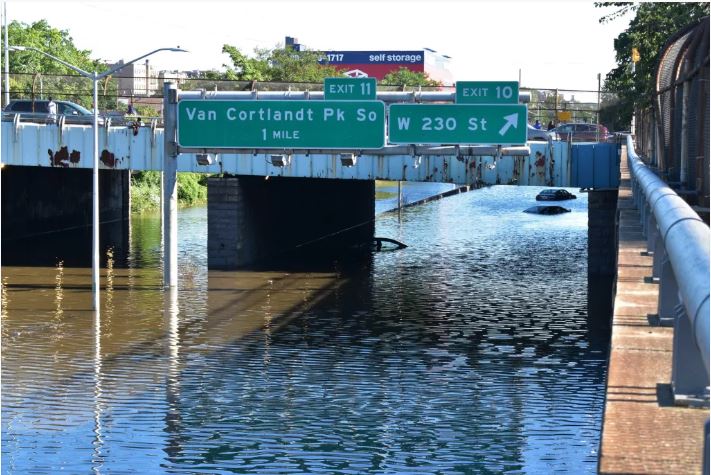
Photo by Miriam Quinoñes
According to City officials, Tibbetts Brook was dammed in the 18th century to form the mill pond in Van Cortlandt Park, and by 1912 it was completely buried underground. They said, today, it is redirected (via sewer piping) into the city’s sewer system at Wards Island Wastewater Resource Recovery Facility. They said the daylighting project would return the brook closer to its natural open-air path, which winds through Kingsbridge (or Kingsbridge Heights) on through Fordham Manor (or Marble Hill) and empties into the Harlem River.
Officials said redirecting Tibbetts Brook (once again) this time away from the sewer system, instead of towards it, is expected to remove roughly 4 to 5 million gallons of water from the system each day, and more on rainy days, reducing treatment costs and greenhouse gas emissions.
They said it should also reduce combined sewer overflows by 228 million gallons annually, improving the overall health of the Harlem River. Additionally, officials said it will instead add much-needed, additional capacity to the borough’s natural drainage network, which could lessen flooding in some areas of the Tibbetts Brook watershed.
After years of stalemate, as reported earlier this year by Norwood News, Mayor Eric Adams announced in January 2023 that the City hit a key milestone in the project, when an agreement was reached with railroad freight company CSX Transportation to purchase a piece of property close to the Harlem River critical to the project for $11.2 million. The railway site is also close to the new Fordham Landing development, as reported.
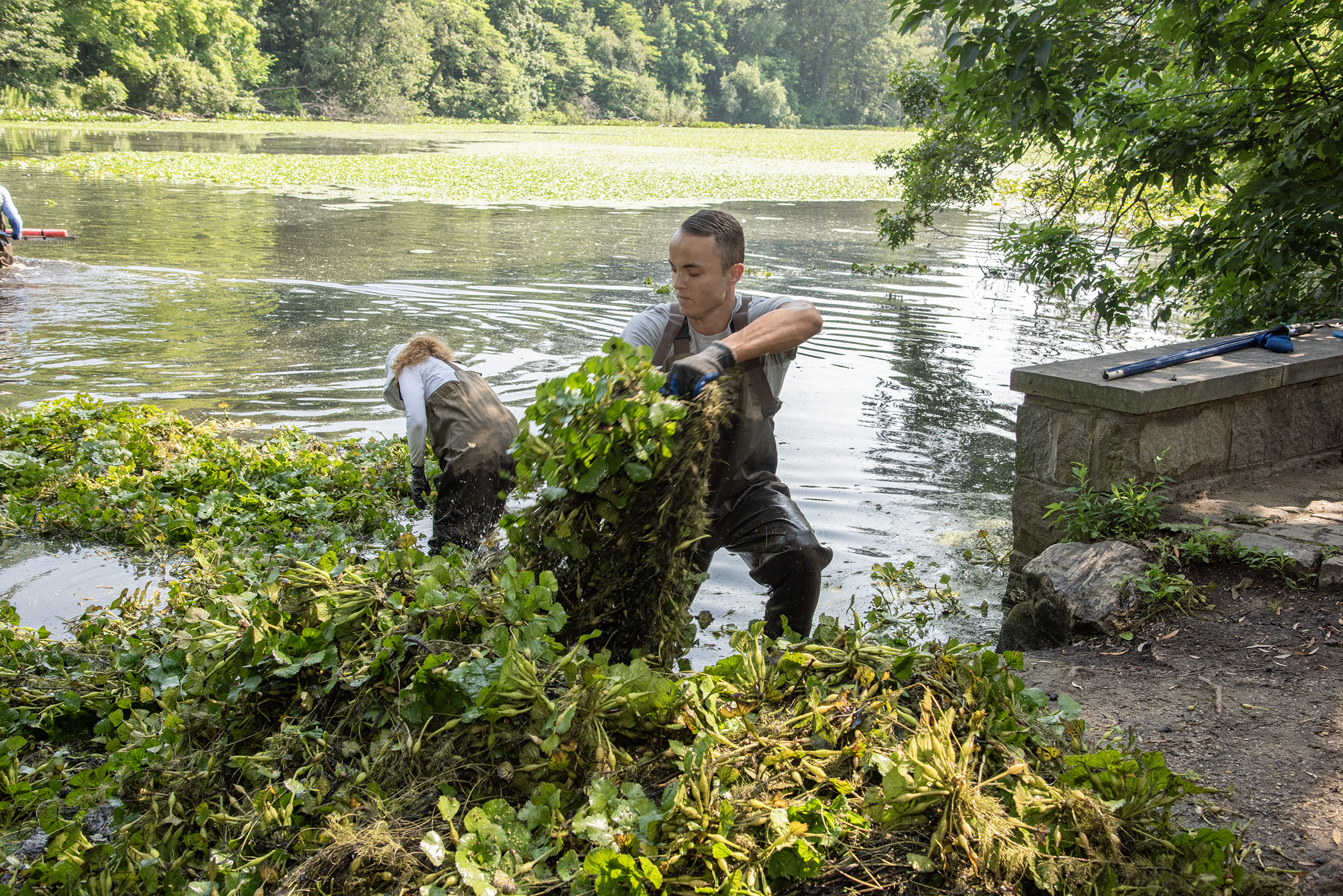
Photo by José A. Giralt
Meanwhile, the overall project budget is targeted at $133 million, and is part of an agreement between New York City and New York State to further improve the ecological health of city waterbodies across the State. The project will also create new parkland on the former CSX rail line property, extending the existing Putnam Greenway south. The greenway currently runs from the 750-mile Empire State Trail south down through Van Cortlandt Park. Acquisition by the City of the former rail line property, for use as parkland, is subject to approval by the federal Surface Transportation Board.
There has already been significant community engagement on the project, which has been presented to Bronx Community Board 8, and it is now in the final stage of the design process. Actual construction is expected to begin in 2025.
When the remnants of Hurricane Ida overwhelmed the underground pipes in September 2021, the result was a flooded Major Deegan Expressway, as reported, where dozens of vehicles became trapped. Taylor is concerned that without the constant vigilance and removal of the invasive water chestnut plant, clogging issues could develop, and contribute to more serious flooding in the area between Van Cortlandt Park and the Harlem River.
“We want to make sure that this problem is taken care of before Tibbetts Brook is daylit, because when they do the daylighting and this water starts flowing down to the Harlem [River], we want to make sure that the water chestnut is not going to travel to the Harlem River,” she explained.
For volunteers like Wilcox, ridding the Hester & Piero’s Mill Pond of its unwelcome plant invasion brings a special sense of communal achievement. He wants to do his part to protect the environment, especially as it relates to his beloved Van Cortlandt Park.
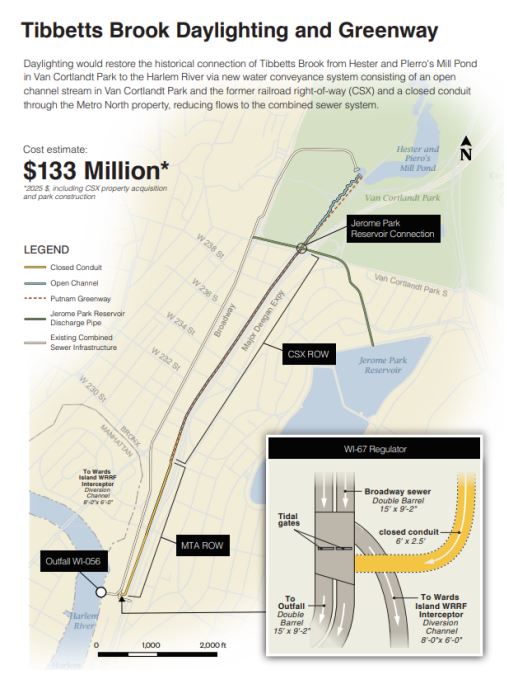
Diagram courtesy of NYC Department of Environmental Protection
“There’s something very satisfying about being able to see your work product at the end of the day,” he said. “With school and college, there’s not the same satisfaction, in my mind, of the well-written paper versus [what] I can look at [at] this lake and see what we’ve taken care of.”
To learn more about volunteer opportunities with the Van Cortlandt Park Alliance, email info@vancortlandt.org or call (718) 601-1460.
*Síle Moloney contributed to this story.




